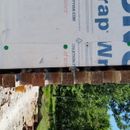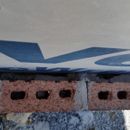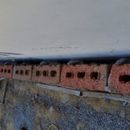Mortar bridging and droppings
General question on Mortar Bridging and Dropping workmanship.(CZ4)
Here are a few images of some brick veneer on a house. Its not mine, but it is from the builder I will be using. I’ve read that droppings and bridging are “bad” but I don’t know what constitutes good vs typical vs poor. So I’ve attached some pictures to get others viewpoint on the quality of this work. There is a single layer of tyvek and then OSB behind that, and I’d say ~1″ of space behind the veneer, at least where there is not bridging.
GBA Detail Library
A collection of one thousand construction details organized by climate and house part














Replies
Stephen,
The photos show unacceptable work. Codes and standards require a minimum air space of 1 inch between the back of the mortar and the WRB. This mason isn't doing that.
Here is a link to a useful guide from the Brick Industry Association: Brick Veneer / Wood Stud Walls.
These days, it's hard to find a good mason, and it's hard to supervise the mason to ensure that the mason doesn't engage in the type of sloppy practices you have documented. That's why designers often specify the use of a three-dimensional plastic drainage mat with fabric on one or both sides. (If you specify a mat with fabric on only one side, the fabric faces the brick veneer.) The fabric keeps the drainage channel free of mortar.
Thanks Martin,
It seemed excessive to me but figured it was better to check with folks in the trade for acceptability guidance.
I'll talk with our builder about my concerns but want to have some options available as well. Reading here on GBA seems like there are a couple of potential paths. I'll assume that I'm not going to be able to police or train in better practices, although it will at least be highlighted. Past that its the add more products to compensate for a lack of skilled trades.
a) standard tyvek + a drain product. Looks like Mortairvent 202 is a popular choice, its a 6mm thick product that you can get for ~.70 sqft. Looks like its the same product as benjamin obdyke home slicker. These sound like the products you mentioned in your response with a single fabric face attached to a drain mat.
b) Would two layers of WRB work as well, and if so what would be the best arrangement. For example I read that standard tyvek covered with #15 felt is a acceptable detail. Perhaps not as good as a full drainage mat, but not as expensive either. If doing this is it better to use a "crinkly" version of tyvek below the felt?
Again thanks for your help, we have not started on the house yet but I've been walking through ones under construction by my builder looking for potential issues so I can get ahead of things.
Stephen,
No, I don't think that two layers of WRB will provide enough drainage behind globs of mortar as shown in your photos. Get the Morairvent product or a product like it.
For more information, see "Flashing Brick Veneer."
Review here for more info about the gap size and WRB selection:
https://buildingscience.com/documents/building-science-insights/bsi-061-inward-drive-outward-drying
John,
The photos prove that the mason isn't following the code requirement for a 1-inch air gap.
That said, you're probably right that the builder may still insist that "everything meets code."
It looks to me as if the space that the mason needed was provided. The problem is that the mason didn't keep the air space free of mortar.
.
If this is a tract house I wish you the best of luck with your builder. Just be prepared for the customary rejection along with the "Technically this isn't your house until you close" followed by the "it will be built to code." statement.
All the builder has to do is make the brick ledge a little deeper when pouring the slab so I'm not so sure I'd lay this blame squarely on the mason.
John Clark,
With the amount of mortar behind the bricks a larger gap won't make much difference. For years the industry standard was 3/4", which worked fine as long as they cleared each course as they were laid. The blame is squarely on the mason.
@ Malcolm and Martin,
Understood. Sometimes I have a hard time judging distances via photo so I don't know if the existing gap is 1 inch or not. Looks like it's beyond 1 inch.
In any case, with the high demand of housing I'm certain the builder will have no problem selling the lot which the OP wants to purchase and the local code official will just keep it moving.
C'est la vie ! ;)
Peter,
There are lots of skilled masons out there. Some of the best are honored at the annual Spec Mix Bricklayer 500 competition in Las Vegas. Here is a news report of a recent event: Bricklayers Think They’re Safe From Robots.
Winners of the recent competition were David Chavez and Miguel Contreras, bricklayers from Houston.
Note that the robot bricklaying machine mentioned in the article is apparently incapable of cleaning up the mortar squeeze-out. Fail.
This is typical spec builder garbage. This is just 1 of many surprises the builder has hiding behind walls. Drywall and in this case, brick veneer, hides a lot of sins/sloppy work.
90% of builders today do sloppy work. That's just the way it is. Volume over quality. Slamming out homes as quick as possible are the marching orders today for builders and contractors.
Most masons today are just day laborers and not proud tradesmen. The true masons from the 50's - 70's are all but dead or retired. The 80's and especially the 90's + changed all of that. As seen here, brick veneers are not the same thing as brick homes built in the pre 1980's era. My brick home I first lived in as a child was a true brick home. In other words, if you removed the bricks, the walls would fall. This "veneer" brick is just that, a facade. If the bricks are removed, the house walls still stand since it is not truly a structurally support wall, it's just a cladding.
Either way, the workmanship in this trade has gone downhill. I wouldn't expect anything less than this sloppy work from the masons of today. Only way of finding a true mason tradesman is in the commercial realm. Even then, they are rare and super expensive to bring to a residential site to do work. Otherwise, the true mason tradesmen are 6 feet under or fishing on a lake.
Martin,
Part of my comments were from the "cynical" part of me but the reality is, even based on the article you linked, it proves my point. That 22 teams from all over the USA came to Vegas. I highly doubt that these rare top 22 mason companies are doing the majority of the residential work of the homes being built today. Come to a job site with me and you will see undocumented, day workers, putting up masonry walls. Unless it's a commercial site, where they check and the regs are stricter, you won't see that.
I wouldn't quantify from the Vegas show of 22 mason companies that "there are lots of skilled masons out there" when compared to yesteryear. Most of the residential masons, framers, etc are not the tradesmen of yesteryear. I can take you to residential job-sites today and the workers will be from Mexico or teenagers who are framing up homes as we speak. They get paid for speed, not quality. The quicker they frame or lay brick, the more $ they make.
There are DOZENS of articles on the web today and even GBA posted NUMEROUS articles about how there is a HUGE SHORTAGE of skilled tradesmen today.
The OP's problem is more of the rule than the exception today.
The Top 10 Hardest Jobs to Fill -
The skilled trades rank high among blue-collar jobs that are hard to fill, according to the Manpower survey. Carpenters, welders, plumbers, electricians and masons are in demand, the survey says.
https://www.monster.com/career-advice/article/top-10-hardest-jobs-to-fill
Per TRADESMEN INTERNATIONAL -
Skilled workers are in high demand in the construction staffing market. Shortages in skilled workers are expected to grow. The average age of skilled workers in America today is 55 years old.
https://www.tradesmeninternational.com/construction-management/what-is-skilled-staffing/
Peter L,
I think you put your finger on it in your description of old load-bearing masonry houses. Probably the reason masonry as a trade isn't as important as it was is precisely because it is now a veneer applied as one of many choices in cladding. It isn't integral to modern construction and doesn't demand the same skills to perform. That in no way excuses the sloppy workmanship. When you go into a trade (or any occupation, no matter how menial) I think you have an obligation to be good at it, or do something else.
Peter,
We're both right.
There is a shortage of skilled masons in the U.S. And there are a lot of skilled masons out there. Both of these statements are true.
Builders who hire masons need to find the good ones. I agree that can be difficult and frustrating in the face of a shortage of skilled masons.